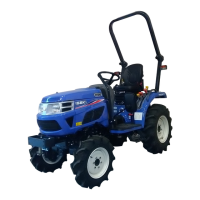SAFETY
11
Loading onto or Unloading from a Truck
(1) When loading the tractor onto a truck or a trailer,
turn off the truck’s engine and apply the parking
brakes to the truck or the trailer.
Otherwise, the truck could move and the tractor falls
to the ground.
(2) Pay sufficient attention to the safety conditions
around the tractor and have it guided by someone
to assist the operation. Never allow other persons to
approach the tractor, especially in front of or behind
it.
(3) When loading or unloading the machine on / off a
truck, set slip-proof ramps at the same angles and
drive the tractor straight at sufficiently slow speeds.
Loading the tractor in reverse travel and unloading
it in forward travel.
(4) Never depress the brake pedal during loading
or unloading operation, or the tractor may shift
sideways, which may cause it to fall of the ramps.
(5) If the engine stalls unexpectedly on the ramps,
depress the brake pedal immediately and roll the
tractor to the ground by manipulating the brake
pedal. Start the engine on the ground and try again.
(6) When the machine is loaded on the truck, stop the
engine, apply parking brakes, and withdraw the
starter key, chock the wheels, and rope it securely
to the truck. During transportation, do not make
sharp turns needlessly so as not to shift the loaded
tractor.
(7) Use ramps with the same or better specifications
mentioned below. When the machine is equipped
with attachments, consult your dealer for advice.
Specifications of the Ramps
• Length.....more than 4 times the height of the platform
of the truck
• Width (effective width).....more than 35 cm
• Capacity (1 ramp).....more than 1700 kg
• Ramps should have anti-skid surfaces
(8) Hook the ramps securely on the platform of the
truck with the top of the ramp level with the platform.
(9) Always prepare for even the worst, by never
allowing other persons near the tractor.
(10) Drive the tractor carefully at the moment the tractor
moves from the ramps onto the platform, for it
changes angle abruptly.
FIG. 16
FIG. 17

